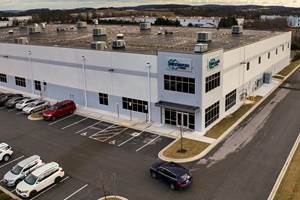Giant blades could spur more growth in offshore energy in U.S.
Sandia National Laboratories’ research is working on designs that are two and a half times longer than any existing wind blade.
A new design for blades longer than two football fields could help bring offshore 50‐megawatt (MW) wind turbines to the U.S. and the world. Sandia National Laboratories’ research on the extreme‐scale Segmented Ultralight Morphing Rotor (SUMR) is funded by the Department of Energy’s (DOE) Advanced Research Projects Agency‐E long, two and a half times longer than any existing wind blade.
The team is led by the University of Virginia and includes Sandia and researchers from the University of Illinois, the University of Colorado, the Colorado School of Mines, and the National Renewable Energy Laboratory Corporate advisory partners include Dominion Resources General Electric Co. Siemens AG and Vestas Wind Systems.
“Exascale turbines take advantage of economies of scale,” said Todd Griffith, lead blade designer on the project and technical lead for Sandia’s
Sandia’s previous work on 13‐MW systems uses 100‐meter blades (328 feet) on which the initial SUMR designs are based. While a 50‐MW horizontal wind turbine is well beyond the size of any current design, studies show that load alignment can dramatically reduce peak stresses and fatigue on the rotor blades. This reduces costs and allows construction of blades big enough for a 50‐MW system.
Most current U.S. wind turbines produce power in the 1‐ to 2‐MW range, with blades about 165 feet (50 meters) long, while the largest commercially available turbine is rated at 8 MW with blades 262 feet (80 meters) long.
“The U.S. has great offshore wind energy potential, but offshore installations are expensive, so larger turbines are needed to capture that energy at an affordable cost,” Griffith said.
Barriers remain before designers can scale up to a 50‐MW turbine — more than six times the power output of the largest current turbines.
“Conventional upwind blades are expensive to manufacture, deploy and maintain beyond 10‐15 MW. They must be stiff, to avoid fatigue and eliminate the risk of tower strikes in strong gusts. Those stiff blades are heavy, and their mass, which is directly related to cost, becomes even more problematic at the extreme scale due to gravity loads and other changes,” Griffith said.
He said the new blades could be more easily and cost‐effectively manufactured in segments, avoiding the unprecedented‐scale equipment needed for transport and assembly of blades built as single units.
The exascale turbines would be sited downwind, unlike conventional turbines that are configured with the rotor blades upwind of the tower.
SUMR’s load‐alignment is bio‐inspired by the way palm trees move in storms. The lightweight, segmented trunk approximates a series of cylindrical shells that bend in the wind while retaining segment stiffness. This alignment radically reduces the mass required for blade stiffening by reducing the forces on the blades using the palm‐tree inspired load‐alignment approach.
Segmented turbine blades have a significant advantage in parts of the world at risk for severe storms, such as hurricanes, where offshore turbines must withstand tremendous wind speeds over 200 mph. The blades align themselves to reduce cantilever forces on the blade through a trunnion hinge near the hub that responds to changes in wind speed.
“At dangerous wind speeds, the blades are stowed and aligned with the wind direction, reducing the risk of damage. At lower wind speeds, the blades spread out more to maximize energy production.” Griffith said.
Moving toward exascale turbines could be an important way to meet DOE’s goal of providing 20 percent of the nation’s energy from wind by 2030, as detailed in its recent Wind Vision Report.
Related Content
RTM, dry braided fabric enable faster, cost-effective manufacture for hydrokinetic turbine components
Switching from prepreg to RTM led to significant time and cost savings for the manufacture of fiberglass struts and complex carbon fiber composite foils that power ORPC’s RivGen systems.
Read MoreHexagon Purus opens new U.S. facility to manufacture composite hydrogen tanks
CW attends the opening of Westminster, Maryland, site and shares the company’s history, vision and leading role in H2 storage systems.
Read MoreDrag-based wind turbine design for higher energy capture
Claiming significantly higher power generation capacity than traditional blades, Xenecore aims to scale up its current monocoque, fan-shaped wind blades, made via compression molded carbon fiber/epoxy with I-beam ribs and microsphere structural foam.
Read MoreJEC World 2023 highlights: Recyclable resins, renewable energy solutions, award-winning automotive
CW technical editor Hannah Mason recaps some of the technology on display at JEC World, including natural, bio-based or recyclable materials solutions, innovative automotive and renewable energy components and more.
Read MoreRead Next
Developing bonded composite repair for ships, offshore units
Bureau Veritas and industry partners issue guidelines and pave the way for certification via StrengthBond Offshore project.
Read MorePlant tour: Daher Shap’in TechCenter and composites production plant, Saint-Aignan-de-Grandlieu, France
Co-located R&D and production advance OOA thermosets, thermoplastics, welding, recycling and digital technologies for faster processing and certification of lighter, more sustainable composites.
Read MoreAll-recycled, needle-punched nonwoven CFRP slashes carbon footprint of Formula 2 seat
Dallara and Tenowo collaborate to produce a race-ready Formula 2 seat using recycled carbon fiber, reducing CO2 emissions by 97.5% compared to virgin materials.
Read More















.jpg;maxWidth=300;quality=90)







